Earlier this year, Western Digital announced the second generation in its WD Black line of enthusiasts SSD, the WD SN750 NVMe. The SN750 is an M.2 2280 SSD with the option of a heatsink for longer peak performance, though it will take up more space. The drive is quoted of hitting speeds in the upward of 3.47GB/s read, 3GB/s write with throughput of 515K IOPS read and 560K IOPS write.
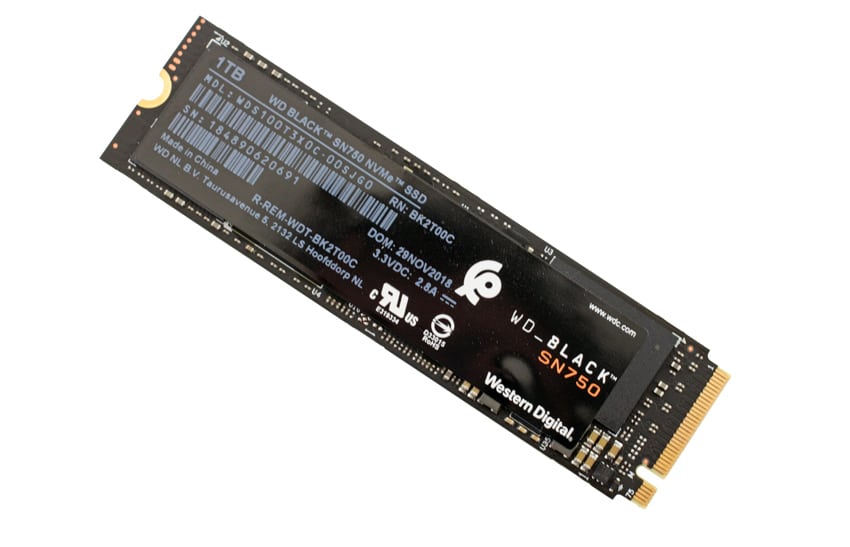
With the WD Black SN750, the company is specifically focusing on PC gamers. While mobile and console gaming is widely popular, the PC gamer is able to tune their systems to get the biggest bang and that is where devices like the SN750 come into play. Leveraging 64-Layer 3D NAND, WD was able to push the capacity up to 2TB that helps store the modern games that can be over 100GB. The above quoted speeds will lead to faster install times, which is beneficial when one loads the games they play to the SSD and leaves those less used on an HDD. The speeds also lead to faster load times, which, honestly, we all would enjoy more. Soon the SN750 will ship with a heatsink allowing for higher performance for longer, for the gamers that go all night.
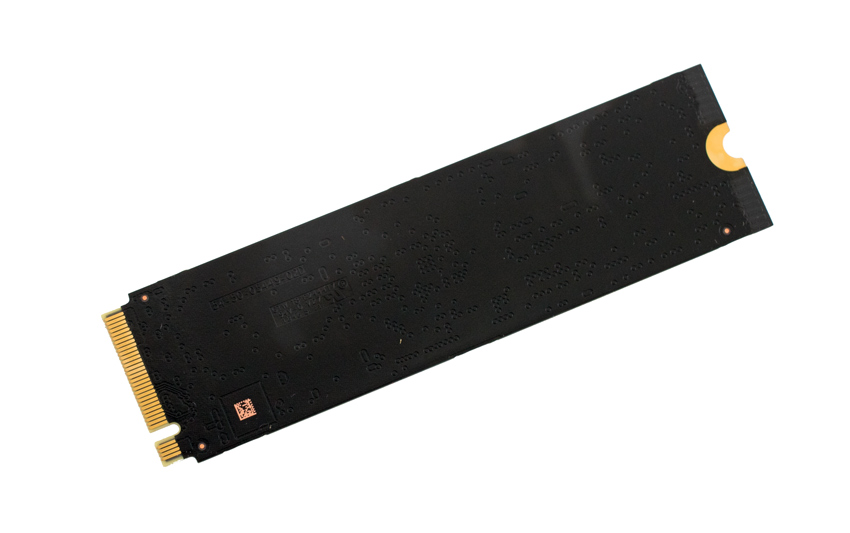
While gaming is the focus, not even gamers game all the time. With social media, gamers record footage of their game and upload it to media platforms such as Twitch and YouTube. Players also connect through Skype and Discord while gaming. The SN750 also makes an ideal choice for those looking utilize social media while gaming or for video recording and editing. Users can leverage the Western Digital SSD Dashboard in order to maintain peak performance of their drive as well.
The WD Black SN750 comes in four capacities (250GB, 500GB, 1TB, and 2TB all single-sided) and with a 5-year warranty. The drive can be picked up for as little as $79. The heatsink model isn’t out yet, so for this review we are looking at the 1TB standard issue drive.
WD Black SN750 NVMe SSD Specifications
| Form factor | M.2 2280 | |||
| Interface | PCIe Gen3 8 Gb/s, up to 4 lanes | |||
| Capacity | 250GB | 500GB | 1TB | 2TB |
| Performance | ||||
| Sequential Read up to (MB/s) (Queues=32, Threads=1) | 3,100 | 3,470 | 3,470 | 3,400 |
| Sequential Write up to (MB/s) (Queues=32, Threads=1) | 1,600 | 2,600 | 3,000 | 2,900 |
| Rand Read 4KB IOPS up to (Queues=32, Threads=1) | 220K | 420K | 515K | 480K |
| Rand Write 4KB IOPS up to (Queues=32, Threads=8) | 180K | 380K | 560K | 550K |
| Endurance (TBW) | 200 | 300 | 600 | 1,200 |
| Power | ||||
| Peak Power (10us) | 2.8A | 2.8A | 2.8A | 2.8A |
| PS3 (low power) | 70mW | 70mW | 100mW | 100mW |
| Sleep (PS4) (low power) | 2.5mW | 2.5mW | 2.5mW | 2.5mW |
| MTTF | 1.75 million hours | |||
| Environmental | ||||
| Operating Temperatures | 32°F to 158°F (0°C to 70°C) | |||
| Non-operating Temperatures | -67°F to 185°F (-55°C to 85°C) | |||
| Limited Warranty | 5-year | |||
| Physical Dimensions | ||||
| Form Factor | M.2 2280 | M.2 2280 with heatsink | ||
| Length | 80 ± 0.15mm | 80 ± 0.15mm | ||
| Width | 22 ± 0.15mm | 24.2 ± 0.30mm | ||
| Height | 2.38mm | 8.10mm | ||
| Weight | 7.5g ± 1g | 33.2g ± 1g | ||
Performance
Testbed
The test platform leveraged in these tests is a Dell PowerEdge R740xd server. We measure SATA performance through a Dell H730P RAID card inside this server, although we set the card in HBA mode only to disable the impact of RAID card cache. NVMe is tested natively through an M.2 to PCIe adapter card. The methodology used better reflects end-user workflow with the consistency, scalability and flexibility testing within virtualized server offers. A large focus is put on drive latency across the entire load range of the drive, not just at the smallest QD1 (Queue-Depth 1) levels. We do this because many of the common consumer benchmarks don’t adequately capture end-user workload profiles.
Houdini by SideFX
The Houdini test is specifically designed to evaluate storage performance as it relates to CGI rendering. The test bed for this application is a variant of the core Dell PowerEdge R740xd server type we use in the lab with dual Intel 6130 CPUs and 64GB DRAM. In this case we installed Ubuntu Desktop (ubuntu-16.04.3-desktop-amd64) running bare metal. Output of the benchmark is measured in seconds to complete, with fewer being better.
The Maelstrom demo represents a section of the rendering pipeline that highlights the performance capabilities of storage by demonstrating its ability to effectively use the swap file as a form of extended memory. The test does not write out the result data or process the points in order to isolate the wall-time effect of the latency impact to the underlying storage component. The test itself is composed of five phases, three of which we run as part of the benchmark, which are as follows:
- Loads packed points from disk. This is the time to read from disk. This is single threaded, which may limit overall throughput.
- Unpacks the points into a single flat array in order to allow them to be processed. If the points do not have dependency on other points, the working set could be adjusted to stay in-core. This step is multi-threaded.
- (Not Run) Process the points.
- Repacks them into bucketed blocks suitable for storing back to disk. This step is multi-threaded.
- (Not Run) Write the bucketed blocks back out to disk.
Looking at the performance of rendering time (where less is better), the SN750 had a score of 2,987.7 seconds placing it in the bottom third of our pack.

SQL Server Performance
We use a lightweight virtualized SQL Server instance to appropriately represent what an application developer would use on a local workstation. The test is similar to what we run on storage arrays and enterprise drives, just scaled back to be a better approximation for behaviors employed by the end user. The workload employs the current draft of the Transaction Processing Performance Council’s Benchmark C (TPC-C), an online transaction processing benchmark that simulates the activities found in complex application environments.
The lightweight SQL Server VM is configured with three vDisks: 100GB volume for boot, a 350GB volume for the database and log files, and a 150GB volume used for the database backup we recover after each run. From a system resource perspective, we configure each VM with 16 vCPUs, 32GB of DRAM and leverage the LSI Logic SAS SCSI controller. This test uses SQL Server 2014 running on Windows Server 2012 R2 guest VMs and is stressed by Dell’s Benchmark Factory for Databases.
SQL Server Testing Configuration (per VM)
- Windows Server 2012 R2
- Storage Footprint: 600GB allocated, 500GB used
- SQL Server 2014
- Database Size: 1,500 scale
- Virtual Client Load: 15,000
- RAM Buffer: 24GB
- Test Length: 3 hours
- 2.5 hours preconditioning
- 30 minutes sample period
When looking at SQL Server Output, the WD Black SN750 was slightly ahead of the previous model with 3,157 TPS scoring below average in the pack tested.

For SQL Server average latency the new WD hit 8ms an improvement over the previous model and roughly in the middle of our pack.

VDBench Workload Analysis
In our first VDBench Workload Analysis, we looked at random 4K read performance. Here, the WD Black SN750 started just under 100μs, which was one of the higher starting latency. As far as peak performance, the WD took second overall with 453,296 IOPS at a latency of 281.3μs.
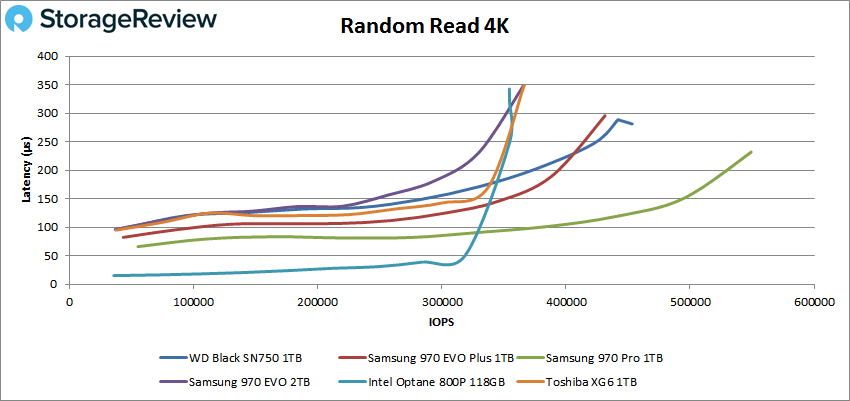
Random 4K read showed a stronger starting latency with all the drives around 25μs. The WD was able to stay under 100μs until about 125K IOPS and went on to peak fourth with 180,918 IOPS with a latency of 704.8μs.
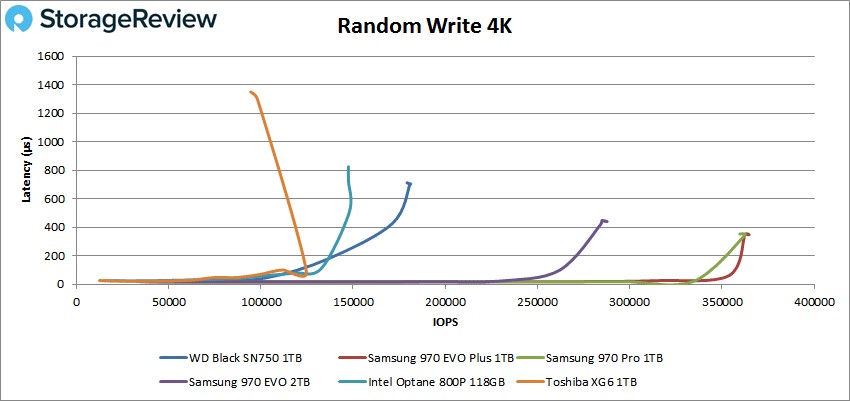
Switching over to sequential workloads, for 64K read the WD Black SN750 started off with the highest latency at 473μs. As far as peak performance goes, the drive came in third with 27,425 IOPS or 1.71GB/s at a latency of 582.5μs.
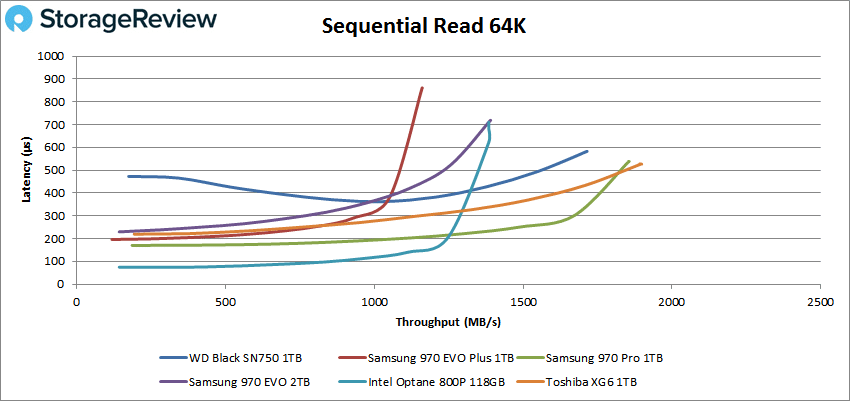
For 64K sequential write again the WD drive had better starting latency in the write around 75μs. The drive went on to peak in fourth place with 16,508 IOPS or 1.03GB/s at 961μs.
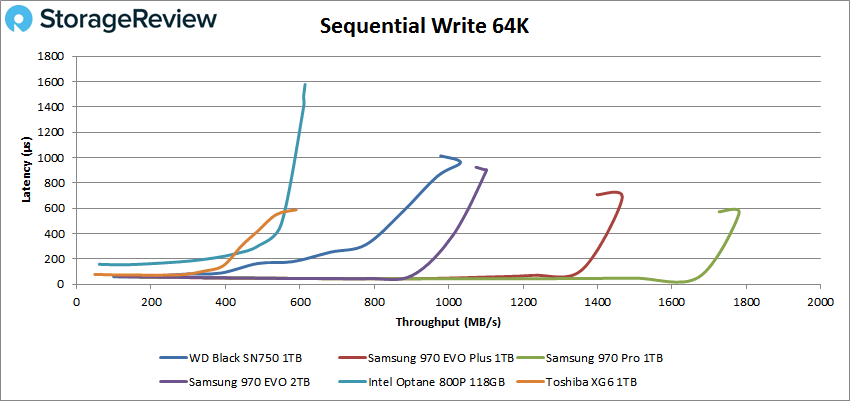
Next, we looked at our VDI benchmarks, which are designed to tax the drives even further. These tests include Boot, Initial Login, and Monday Login. Looking at the Boot test, the WD drive started with latency around 125μs higher than most of the drives in our pack. The WD went on to peak in second place with 115,170 IOPS at a latency of 282.5μs.
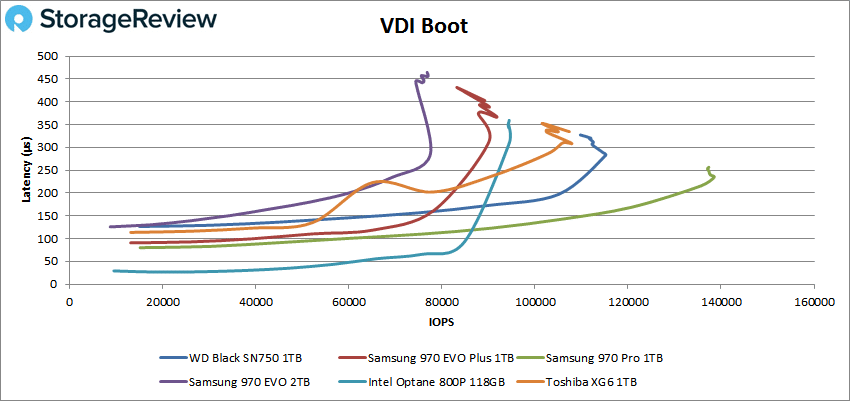
For VDI Initial Login we see the WD drive start off with the highest latency of 358.6μs. It went on to peak at second to last with 33,423 IOPS at a latency of 893.7μs.
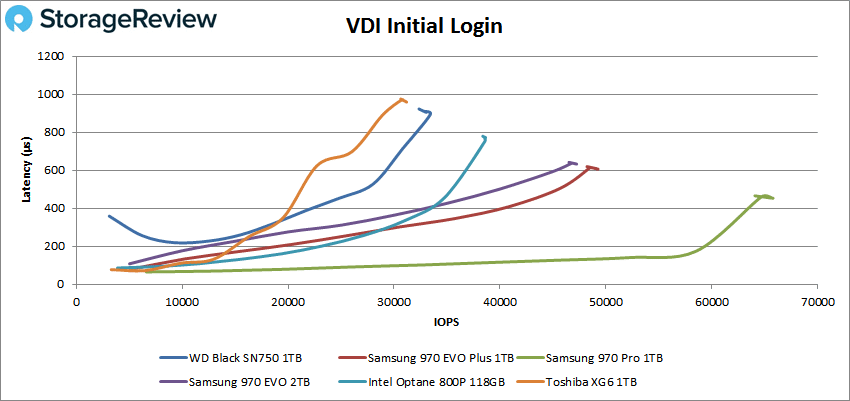
With VDI Monday Login the WD drive started off below 100μs but quickly went over. The drive peaked at 40,907 IOPS with a latency of 389μs.
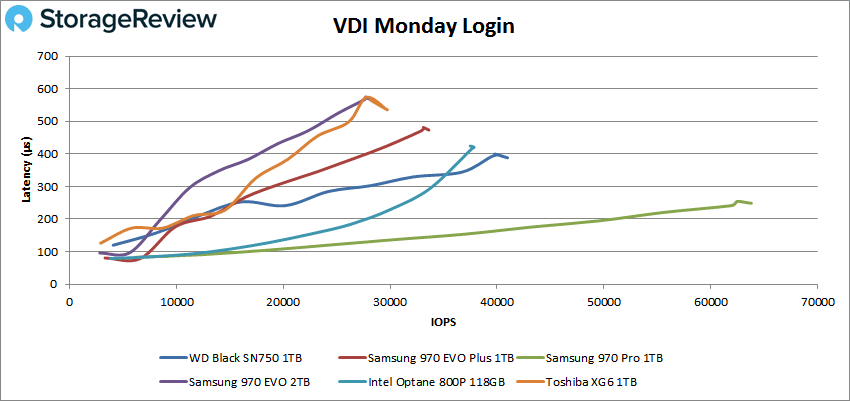
Conclusion
The WD Black SN750 is the second generation of the WD Black line with a specific focus on gamers this time around. Coming in a compact M.2 2280 form factor, the drive comes in capacities ranging from 250GB to 2TB. The drive has quoted performance as high at 3.47GB/s read, 3GB/s write with throughput of 515K IOPS read and 560K IOPS write. The drive will have a future version with a heat sink for sustained high performance that is more critical to the target gaming audience. The SN750 leverages the Western Digital SSD Dashboard to maintaining peak performance of the drive in times of gaming or other operations down with their PCs.
For our application workload analysis we tested the WD Black SN750 using Houdini by SideFX as well as our SQL Server benchmark. For the Houdini test the SN750 had a score of 2,987.7 seconds. This puts it right behind the previous version of WD Black and in the bottom third of the drives tested. For SQL Server the WD Black SN750 had a transactional score of 3,157 TPS with an average latency of 8ms.
For VDBench performance, the WD Black SN750 had a few strong starting latency, particularly in writes, its peak performance was more of a mixed bag. In random performance the drive hit peaks of 453K IOPS read and 181K IOPS write. Sequential saw peaks of 1.71GB/s read and 1.03GB/s write. For our VDI tests the drive hit peaks of 115K IOPS for boot, 33K IOPS for Initial Login, and 41K IOPS for Monday login. The WD Black SN750 was able to maintain sub-millisecond latency performance throughout all our VDBench tests.
The WD Black SN750 provides mainstream performance, planting itself middle to upper middle in most of our tests. As price comes down, the SN750 has a good opportunity to appeal to a broad customer base.




 Amazon
Amazon